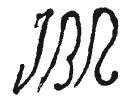 |
: June 2003 |
||||||||
| Discovery context: A famous collector, specializing in stoneware from Berry and Puisaye, bought this whistle in a setting giving it no context. His curiosity was attracted because it had both an inscription and a date: 1834. It is unusual for a potter to sign such a modest item, carelessly made in a rough clay. The collector could not identify this item as a piece made in the ceramic centers for which he is a recognized specialist.
General description:
|
 L max: 11 cm H max: 6,3 cm lmax: 6,3 cm |
||||||||
 Mourtrouy ?? 1834 |
The inscription: At the center of the lower aspect of the whistle are three initials (height: 0.6 inch):  The letters J B R are easily readable. On the right side of the initials,written vertically on the whistle's flank is an inscription in smaller characters (approximately 4mm ). On first glance, it can be interpreted in as "Mourtrouy". Below, the date 1834 is framed within an oval. The letters J B R are easily readable. On the right side of the initials,written vertically on the whistle's flank is an inscription in smaller characters (approximately 4mm ). On first glance, it can be interpreted in as "Mourtrouy". Below, the date 1834 is framed within an oval.
|
||||||||
| Study of the object:
Typology:
|  Cox, early 20th century |
||||||||
|
Inscriptions: A potter's inscription on a significant work generally includes the maker's name, the place of manufacture or the name of the customer. In the absence of "by me...", "made in...", "for...", etc., each interpretations is possible for the initials and for the word " Mourtrouy ". Research among the French patronyms did not reveal any names close to "Mourtrouy". The inscription can be also read: "Moi a trouy" (Me in trouy) because "A" is sometimes written with a similar written form in other dedications by potters. Though Trouy is a village in Berry, no pottery has been recorded there. It also would be surprising for a potter not to capitalize the name of his village. On a closer examination, the "Y" is revealed as a "X". A light line, obscured by the glaze, is in fact a branch of the "X". With this in place, the word can now be read as "Mourtroux". Though there is no French village with this spelling, there are two villages called "Mortroux", a term deriving from monasteriolum or "small monastery". As far as the spelling is concerned, the phonetic deformation of "OU" in "O" is frequent in toponymy. One Mortroux is in Creuse (center of France) and the other in Belgium (province of Liege). By excluding the Belgian Mortroux because of the shape of the whistle, Mortroux in Creuse becomes a good candidate for our whistle. Unfortunately, Tardy, in a French index of all pottery centers in France, does not include this village. It is Maurice ROBERT's book "the folk potteries and the potters in the Limousin and the Marche (from the 18th century to the present time)" (1972), which provide the solution.
|
|||||||||
| Solution:
Though curiously forgotten in Tardy's book, Mortroux is a pottery center. Best known for its anthropomorphic finials of the 17 and 18th centuries, the most remarkable in the Limousin, common crockery was also manufactured there.In the few surviving pieces, the clay is reddish in colour. The glaze used on the whistle conforms to that of the potteries of Mortroux.
Thus, this simple whistle has made it possible to fill the typological vacuum of the pyriform shapes of whistles between the southwest and the center of France; to discover an unknown center of whistle production. We confirm that during the 19th century, apprentices started learning their work by trying to make whistles, just as they did later. Yes, a whistle can speak to us!
|
|||||||||